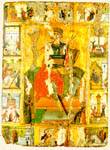|
|
| Portable Icons |
16th c., last quarter Monastery of St Paul Wood, egg tempera, 85 x 63 cm |
|

|
In the centre of the icon, within an integral frame, St George sits on a backless throne, his feet on a footrest. He wears a long green tunic, a breastplate, and a red chlamys that forms elaborate folds on his right leg. His left arm encircles a bow and arrows; in his partly ruined right hand he holds a spear. He is identified by an inscription in Old Slavonic script: 'St George'. In the lower part of this central section are three full-length figures in attitudes of supplication. On the left is a man wearing a crown and a richly woven sleeveless cloak, accompanied by the inscription: 'Ιω ΠΕΤ[---] ΒΟΕΒΟΔ(Α)' (IΩ Pet[---] Voivode). On the saint's right are a woman and a child. The woman's cloak, sleeveless like the man's, is red and ornamented with gold two-headed eagles. These two figures are accompanied by the inscriptions: 'Ιω ΜΑΡ[Ι-ΒΟΕ]ΒΟΔ(Α)' (IΩ Maria Voivode) and 'ΙΩ Β]ΙΛΑ (ΝΤ) ΒΟΕΒΟΔ(Α)' (IΩ Vlad Voivode). The central representation is surrounded by twelve small rectangular panels illustrating incidents from the life and martyrdom of St George in no coherent chronological order. Old Slavonic inscriptions identify the scenes. The cycle of the life and martyrdom of St George, which is based on the Synaxarium Ecclesiae Constantinopolitanae, appeared in the monumental painting of the eleventh to twelfth centuries in Hagia Sophia, Kiev (1046-67), and the Church of Hagioi Anargyroi, Kastoria (ca. 1180; Walter 1989, pp. 347-54). As regards portable icons, the earliest example is an icon of the late twelfth to thirteenth century at Sinai (Soteriou 1956, fig. 167), in which the saint is depicted standing in the centre, surrounded by twenty scenes relating to his life, miracles, and martyrdom. The cycle of the Life of St George enjoyed relatively wide dissemination thereafter, thirty-seven iconographical cycles having been recorded from between the tenth and the fourteenth century (Mark-Weiner 1977). On the basis of its technical and stylistic features, as also the data gleaned from the portrayal of the donors, the icon may be dated to the sixteenth century. More specifically, the inscription accompanying the male donor indicates that the icon was the gift of a ruling prince of Wallachia named Peter and his family. We know of five ruling princes of Wallachia and Moldavia in the sixteenth century named Peter (Hurmuzaki 1909, pp. 335-8), one of whom, Peter the Good (1554-8), is known to have had links with the Monastery of St Paul. Smyrnakis reports that the construction of the tower in the south-east corner of the monastery began in the reign of Neagoe Basarab (1512-21) and was completed in the reign of Peter (1554). So it could well have been Peter the Good, who contributed to the completion of the tower, who donated this icon to the Monastery of St Paul. However, the epigraphical data in fact point to Peter the Lame, whose wife was named Maria and whose son was named Vlad, like the figures in the icon. Peter the Lame of Wallachia was three times voivode in the last quarter of the sixteenth century - in 1574-8, 1578-9, and 1582-91 - and the icon may reasonably be dated to this period. This icon of St George, to whom the old katholikon (1447) was dedicated, seems to have been one of the despotic icons on the iconostasis in the katholikon in the mid-sixteenth century, together with two others of like size, which survive in the monastery and depict Christ Pantokrator and the Virgin Hodegetria. All three, together with others from the iconostasis, which were painted by the same artist and no longer survive, were the gift of Peter, ruling Prince of Wallachia.
| |
|
Bibliography: Unpublished.
| ||
| E.N.T. | ||
| Index of exhibits of Monastery of St. Paul's 16th century |
||
Reference address : https://www.elpenor.org/athos/en/e218ab77.asp